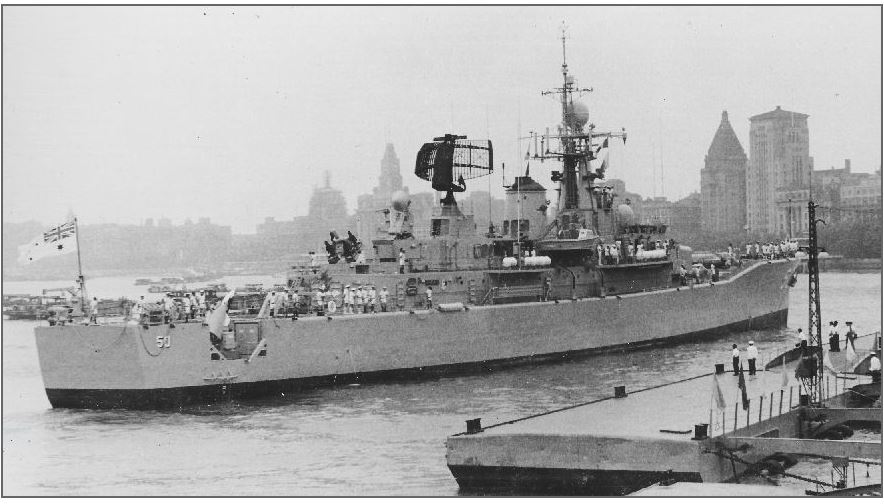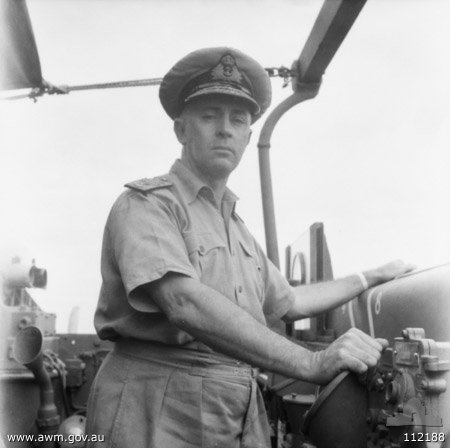- Author
- A.N. Other
- Subjects
- Australian Warships
- Tags
-
- RAN Ships
- None noted.
- Publication
- December 2021 edition of the Naval Historical Review (all rights reserved)
By Kate Reid-Smith
In the early twentieth century, Australia’s first Chief of Navy, Vice Admiral Sir William Rooke Creswell, suggested the nation’s future path lay outside Imperial Britain. It was an arbitrary concept for Australia’s defence planners, and as subjective as it was speculative. Not only did he recognise how much Australia’s defence would be shaped by maritime geographies, he also predicted how changing global politics would influence those capabilities over time. Salient strategic foresight that a century or so later, has more than come to fruition.
When Creswell argued his case, Australia remained within the close embrace of the Commonwealth Defence family. RAN crews and ships trained exclusively with RN counterparts, creating extended, seamless capabilities forming the backbone of globalised British Defence Strategy. Politicians, practitioners and policymakers alike argued against him, mainly because defence thinking remained firmly grounded in absolute capability of Empire. An approach rationalised at the 1911 Imperial Conference, that as Australia lacked any potential threats it did not warrant any type of larger offensive RAN fleet capability, but it did smaller, more RN-friendly ones. By WWI, Australia’s first underwater submarine strengths of AE1 and AE2 were in service, and were warmly welcomed by the Admiralty, firstly in German New Guinea and later elsewhere including Gallipoli. In the aftermath of war and amid global depression, that welcome was cut short. Like Britain, Australia was dominated by domestic financial stringencies, and hampered by Washington Naval Treaty (1922) outcomes. Both effectively kneecapped Australia’s earliest search for maritime defence self-reliance.
The Treaty aim was to prevent global arms races, by restricting weapons of mass destruction, predicated on naval construction. Navies were then the equivalent of today’s nuclear-powered vessels and nuclear weapon arsenals, when the size of naval craft and their concomitant fire power was the threat. Firepower parity was key, and of the three global maritime powers of the time, London and Washington were allotted highest capital ship tonnages of 525,000 tons, while Tokyo was snubbed. It meant little for ‘threatless’ Australia, because the RAN became poster child for Britain’s commitment to arms limitations – the Empire’s contribution to naval disarmament was the scuttling of the nation’s only battlecruiser and flagship, HMAS Australia (I). Government defence investment was abruptly halted, skeleton crewed vessels were tied up alongside or semi-commissioned. Hundreds of personnel were made redundant without pay or pension, wages slashed and recruitment frozen. Overnight, all foundations of Australia’s home-grown littoral defence vanished.
Meanwhile, Britain’s Fortress Singapore and the USA’s Fortress Hawaii (Pearl Harbor) and their navies were expanding. Japan too was busily capacity-building, albeit with what the Western military bible Jane‘s reported was obsolete hardware, outdated weaponry and archaic training methods. British regional defence thinking remained relatively unchanged until the 1930s, and even then the only considered potential challenges to Asia-Pacific Empire interests were remote, emerging further north in China, or further east in the German or French Pacific, and by 1939, even further away in Western Europe. When war arrived in Australia’s backyard in 1941, the flaw in dismissing Japan as a comparative threat was exposed, when its advanced sea and air capabilities decimated Pearl Harbour (1941) and Singapore (1942).
The bombing of Australia’s north including Darwin (1942) helped awaken Australia’s traditional defence complacencies. Britain was preoccupied with island self-defence rather than fulfilling Fortress Singapore obligations, and Australia was still sending large numbers of frontline defence assets to the Eurocentric theatre of war – most of the RAN were fighting in the Atlantic or Mediterranean. Left with little defensive, let alone any offensive, capabilities in the face of seemingly unstoppable Japanese aggression, Canberra’s kneejerk response was to recommence home-grown investment into homeland maritime defence. That included requisitioning small and medium craft, ceasing all civilian shipbuilding, and transitioning shipbuilders into building small surface combatants for purposeful maritime defence. Without lead-in times, the only thing Australia could hope was that Japan did not turn its attention south too soon before some of them came on line.
Greater East Asian Co-Prosperity Sphere
Although Western interests considered themselves materially superior, it was Japan’s successful exploitation of non-material influences that directly influenced speedy unfettered expansionism. Capitalising on burgeoning anti-colonial movements, and linking national identity with economic independence across non-European populations, reinforced welcoming Japan’s Greater East Asian Co-Prosperity Sphere within an ‘Asia for Asians’ mandate. Substantive pre-war negotiations with Vichy French-Indo China and pro-Japan Thai interests signified a regional inclusivity of sorts, and provided Japan exclusive lethal efficacy in accessing airfields, harbours and military personnel.
Japanese pre-war intelligence focusing on coastal, island or atoll sustainabilities in communications, transport and supply lines, meant faster and wider deployment of invasionary forces, followed rapidly by even lighter travelling occupational units. These were different warfighting approaches from permanent forward-basing strategies, usually centred around defensive capacity rather than offensive capabilities, that had been exposed as easily prone to offshore bombardment and onshore air attack. All were used to maximum effect by 1942, when Japan gained contiguous control of the major maritime nexus linking the Pacific and Indian Oceans, and important global sea lanes of communication in the Malacca and Sunda Straits.
For Australia, these were unprotected northern maritime approaches to the mainland, and there was nothing Australia could do to defend them. There was no submarine, air or any fleet capability of defending Australia’s air-sea gap, let alone its vast coastline.
As war progressed, Australia’s new reality was that defence was no longer Empire entwined, nor was Empire the panacea for Australia’s future security. A shift recognised in Washington in 1946, when RAN Commodores John Collins and Harold Farncomb met with their USN counterparts, discussing how Australia’s navy had proved its maritime mettle with another professional navy, outside the Commonwealth or Empire. In an unknown future world, and even more increasingly unfamiliar region, becoming an independent signatory member to the United Nations and Article 51, including the right to self-defence, established Australia’s future security path.
The duality was acknowledging self-defence responsibilities including limitations, while accommodating regional defence priorities. Canberra’s 1947 Five Year Defence Plan encouraged more of the same, irrevocably signalling Australia’s shift away from traditional Imperial British mandates, to something more progressive. Mutually beneficial reciprocal defence pathways with a new friend and ally were opening up, culminating in the ANZUS Treaty. At least Australia was moving from an amorphous defence approach into a more realistic autonomous one.
As the post-war world fractured into Cold War bipolarisation, Australia’s new defence role was fitting into Western Security strategising within the emerging nuclear world. That meant militarily and diplomatically supporting containment policies of alignment, non-alignment or neutrality as required, but again, Australia still faced the same domestic resource exploitation quandary as it did in Creswell’s day. Although Imperial chagrin was replaced with Cold War anxieties, Australia’s security was now one also mutually shared by everyone else in this new region of Association of Southeast Asian Nations (ASEAN). Nobody had nuclear powered anything let alone nuclear weapons, everybody had smaller navies, armies or air forces, and all were subject to the whims of Soviet versus American tit-for-tat nuclear or other threats.
Outdated warfighting concepts
Despite this, regional warfighting tactics still centred around readily identifiable, well-defined, conventional armed conflict, primarily targeted against opponent military forces. It was this forward defence strategy focused on outdated warfighting concepts of long-range attrition, rather than littoral or air-sea gap protection, that informed Canberra purchasing six Oberon-class, diesel engined submarines with anti-surface and anti-submarine capabilities from the UK in the 1960s. Adding advanced American technologies including fleet sensors, and some combat weapons systems in the 1970s, strengthened Australia’s conventional commitment. That the Oberons were replaced by Collins-class, diesel-electric conventional submarines only reinforced more of the same. The trouble was, however, that by the time the Cold War ended in 1989, regional nations were already heading down new warfighting pathways, and nearly all of them involved nuclear vessels and weapons. Australia was not one of them.
The dilemma for Australia’s regional defence paradigm was that it had been relatively static since 1945. It remained centred around readily identifiable, common threats, addressed through mutually reciprocal geostrategic reliance, usually influenced by global geopolitical change. Bipolarisation was now dead, as were ideological ‘Communist’ threats, Britain was engrossed with its European Union identity, the US continued searching for its new role in a new world order, and Australia’s role as regional Western representative fell apart.
RAN warfighting capabilities
Once more considered the ‘threatless’ orphan in the immediate Cold War aftermath, similar 1920s debates surrounding Australia’s defences reappeared, especially as the world again fell into recession. This time however, the Australian government’s cost-cutting exercise was civilianising and outsourcing as many RAN roles and responsibilities as it could. Realtime RAN warfighting capabilities, including the submarine fleet, fell to almost the same comparative incapabilities, including unsustainable long-range deployments, as their 1941 counterparts. By the twenty-first century all would become moot points, when the world’s largest concentration of nuclear weapons lay not in Europe nor the Americas, but directly due north in Australia’s own geostrategic backyard. Among them were now included current and emerging nuclear-capable fleets in Iran, India, Indonesia, Japan, North Korea, Pakistan, South Korea, Taiwan, Thailand, Vietnam, and the most recently arrived global superpower on the doorstep, the People’s Republic of China (PRC).

China’s arrival culminated in decades-old non-material strategising. While routine Cold War politicking dominated international multilateral relationships, China was busy pursuing its own form of diplomacy with Chinese characteristics. Bilaterally using its One-Nation Policy and Five Principles of Peaceful Co-Existence, including non-interventionist policies, it offered individual nations of any political, economic or military persuasion, an alternative to Cold War bipolarisation.
Diplomatic inclusivity that culminated in a majority vote for China gaining readmission to the UN in October 1971 was followed closely by Australian and US rapprochement in 1972. It was also the same time the People’s Liberation Army-Navy (PLAN), announced future defence intentions of a sea-based nuclear deterrence force, although the message was drowned out by US and Soviet rivalries in underwater nuclear deterrent advances. By the early 1980s, China deployed its first nuclear-powered attack submarine, and acquired advanced Soviet and French technologies including sonar, vastly improving submarine force capability. Goodwill visits were encouraged, beginning with the 1981 friendly visit by HMAS Swan (III), the first by an RAN warship in thirty-two years, and culminating twenty years later in October 2001, with the PLAN’s first official visit by frigate Yichang and tanker Taicang during Australian Federation celebrations.
In the intervening two decades, China went from small skirmishes with Vietnamese fishing vessels on uninhabited rocky outcrops, to launching its first home-grown nuclear powered ballistic missile submarine, followed by nuclear aircraft carrier fleets. Major military infrastructure building included subsurface military highways interlinking offshore islands Hainan, Hong Kong and Macao with the mainland. Government-sanctioned logistic China Oceanic Shipping Company Offices (COSCO) are in all regional countries including Australia, only landlocked Laos is excluded. Despite contrary 2016 UNCLOS determinations, China’s maritime reclamation efforts are broaching almost contiguous control of South China Sea SLOCS. Further offshore, user-friendly deepwater harbours and ports including soon to be developed Pakistan’s Karachi Coast, add to China’s bluewater capacity – although in fairness, the US is doing the same in Indonesia’s Riau Archipelago, on Palau in the Pacific, and is supplemented by troop rotational forces in Australia. All of which tells us that China’s global and regional maritime mobility is on the rise, but here’s the rub.
Two caveats
When Australia’s current Chief of Navy, Vice Admiral Mike Noonan, responded to the Federal Government’s decision to replace the aging Collins with a nuclear-powered replacement submarine fleet, there were two caveats. The first was that the Collins would be playing at least a decade long waiting game and would need a life-of-type extension. The second caveat was that Australia’s maritime strategic needs would be hampered by an aging submarine fleet facing less freedom and greater risk of detection – both of which are the stealth bread and butter of subsurface warfare. The second of the major reasons why the latest Australia-United Kingdom-United States (AUKUS) agreement has come into force is mainly because Australia’s self-reliant defence capacity since Federation has not progressed sufficiently. Despite that, navies have always been at the forefront of technological change, whether that be morphing from wooden sailing ships engaged in close quarter combat, to turbine powered battleships battling each other over the horizon. The advent of nuclear-powered Australian submarines – at this stage not nuclear weapons – is just another example of the RAN’s next technological evolution, into becoming a responsive twenty-first century navy.
Select Bibliography
Australian Maritime Doctrine, Canberra: Commonwealth of Australia, 2000.
Australian Maritime Doctrine 1, Canberra: Commonwealth of Australia, 2010.
Australian Submarine Squadron – 21 Years, Canberra: Department of Defence, 1988.
Evans, Alun. A Navy for Australia, Sydney: Australian Broadcasting Corporation, 1986.
Forbes, Andrew. ed. The Strategic Importance of Seaborne Trade and Shipping: A Common Interest of Asia Pacific, Canberra: Australian Seapower Centre, 2003.
Frame, Tom. A History of Australian-American Naval Relations, Sydney: Hodder & Stoughton, 1992.
Greens, Andrew, ‘Australian Defence Force may use Collins Class submarines for another 30 years while waiting for nuclear replacements’, in ABC NEWS, Friday, 15 October 2021, https://www.abc.net.au/news/2021-10-15/ageing-collins-class-subs-stay-nuclear-submarines/100542696 (accessed 16 October, 2021).
Hawksley, Humphrey. Asian Waters the Struggle over the South China Sea and the Strategy of Chinese Expansion, London: Duckworth Overlook, 2018.
Kay, Stuart. Australia’s Maritime Boundaries, Wollongong: Centre for Maritime Policy University of Wollongong, 1992.
Stevens, David and John Reeve. eds. Sea Power Ashore and in the Air, Ultimo: Halstead Press, 2007.
Wilmot, Ned. Strategy & Tactics of Sea Warfare, London: Marshall Cavendish, 1979.






